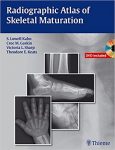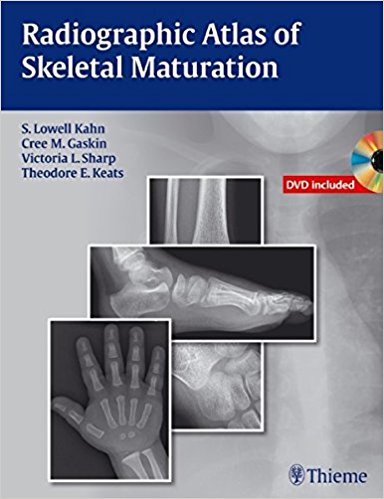 Authors: S. Lowell Khan, MD; Cree M. Gaskin, MD; Victoria L. Sharp, DO; and Theodore E. Keats, MD
Authors: S. Lowell Khan, MD; Cree M. Gaskin, MD; Victoria L. Sharp, DO; and Theodore E. Keats, MD
Programming: Bing Li, PhD
Publisher: Thieme – 605 pages, with 2,300+ images
Book Review by: Nano Khilnani
This textbook contains more than two thousand radiographic images of the components of the human skeleton in two sections: the first one is of males, and the second one, of females. The images shown are of parts of the skeleton of males and of females ranging in age from newborns to 21 years of age.
Section I. Male – This section consists of radiographic images of parts of the male skeleton in this order: skull, cervical spine, thoracic spine, lumbar spine, chest, shoulder, humerus, elbow, forearm, wrist, hand, pelvis, femur, knee, tibia and fibula, ankle, and foot.
Section II. Female – This section consists of radiographic images of the female skeleton in the same order: skull, cervical spine, thoracic spine, lumbar spine, chest, shoulder, humerus, elbow, forearm, wrist, hand, pelvis, femur, knee, tibia and fibula, ankle, and foot.
The editors point out in the Preface that skeletal radiographs of patients remain at the crux of the initial diagnosis for discovery of abnormalities, conditions, diseases, or disorders in emergency and outpatient settings. But in order to do this successfully, a close visualization and comprehensive understanding of what is normal in a skeletal image is essential for correct interpretation. That is the basic rationale for this book.
“This knowledge is particularly difficult to master in the pediatric population due to the typical complex growth of the human skeleton. The misinterpretation of normal anatomy is not without
Consequence, including costly workups, excess ionizing radiation, potentially harmful interventions, and perhaps, most importantly, the medical angst associated with the wrong diagnosis,” the editors write.
The radiographs show each component of the above-mentioned skeletal parts of typical normal males and females with frontal and side-view images at these ages in their lives: neonate, 3-months, 6 months, 9 months, I year, 15 months, 18 months, 21 months, and their age each year from the time they were 2 years old until they reach 21 years of age.
They express thanks to the late Dr. Theodore Keats who was a pioneer in teaching skeletal radiology through illustration with normal roentgen anatomy. They describe him as their ‘inspiration’ for this book and ‘invaluable consultant’ in its development. They point out: “Digital radiography and our shift from plain film to picture archiving and communication system (PACS) workstations have allowed us to expand on his work with enhanced image quality, a wide array of image modification tools, and a large sample size from which we selected our images.
A large number of individuals were reviewed for each age in order to choose an ‘average’ specimen, but the editors caution that this atlas should in no way be construed as a reference for appropriate bone age. One should refer to other publications that correctly depict that, as well as their own on this subject entitled Skeletal Development of the Hand and Wrist: A Radiographic Atlas and Bone Age Comparison.
This present book was developed for the purpose of providing a comprehensive set of reference images that show the development of skeletal maturation “demonstrating the configuration, density, and relative size of the various body parts for males and females.”
This book not only enables radiologists to learn in what ways skeletal parts of younger patients are different from older ones, but to also differentiate normal from abnormal bones. Dr. Keats writes: “The justification for this effort is nicely reflected by two axioms set forth by John Caffey, the father of pediatric radiology. Dr. Caffey stated that one must first know the normal before he can recognize the abnormal. Secondly, he asserted that there is not greater error than misinterpretation of the normal as abnormal.”
The chief value of this rare and outstanding book on skeletal maturation is the presentation of a huge number of skeletal images of patients at a very large age range, from newborns to 21 years old. This enables radiologists to learn through observation, make correct interpretations, and prescribe the appropriate course of treatment. This is an excellent resource.
As an additional benefit, a DVD is attached on the inside back cover of this book.
Authors:
Lowell Khan, MD, MBA is Assistant Professor of Interventional Radiology and Surgery at Tufts University School of Medicine. He is also affiliated with Baystate Vascular Servces at Baystate Medical Center in Springfield, Massachusetts.
Cree M. Gaskin, MD is Associate Professor of Radiology and Orthopedic Surgery, Vice-Chair at Radiology Informatics, and Director of the Musculoskeletal Radiology Fellowship at University of Virginia Health System in Charlottesville, Virginia.
Victoria L. Sharp, DO is affiliated with Lincoln Memorial University – DeBusk College of Osteopathic Medicine. and a General Surgery Resident at Botsford Hospital in Farmington Hills, Michigan.
Theodore E. Keats, MD (deceased) was a former Alumnus Professor of Radiology at University of Virginia Health System in Charlottesville, Virginia.
Programming:
Bing Li, PhD is Research and Development Manager of Reticle and Photomask Inspection Division at KLA-Tencor in Shanghai, China.







